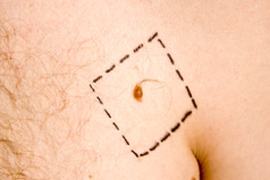What Is Melanoma?
Melanoma is the most serious form of skin cancer. To reach a more complete understanding, it is necessary to learn how the cells in the body become malignant.
The Origin of Melanoma
Melanoma is a malignant tumor that originates in melanocytes, the cells which produce melanin that colors our skin, hair, and eyes and is heavily concentrated in most moles. The majority of melanomas are black or brown. However, they occasionally stop producing pigment. When that happens, the melanomas may no longer be dark, but are skin-colored, pink, red, or purple.
Some Are More Dangerous
The physician will tell you whether the melanoma is early or advanced by describing it as either in situ or invasive. Melanomas in situ occupy only the uppermost part of the epidermis, the top layers of the skin. Invasive melanomas are the more serious, as they have penetrated more deeply into the skin and may have traveled from the original tumor through the body.
The Four Basic Types
- Superficial spreading melanoma is by far the most common type, accounting for about 70 percent of all cases. As you might expect, this melanoma travels along the top layer of the skin for a fairly long time before penetrating more deeply. The first sign is the appearance of a flat or slightly raised discolored patch that has irregular borders and is somewhat geometrical in form. The color varies, and you may see areas of tan, brown, black, red, blue, or white. Sometimes an older mole will change in these ways or a new one will arise. The melanoma can be seen almost anywhere on the body but is most likely to occur on the trunk in men, the legs in women, and the upper back in both.
- Lentigo maligna is similar to the superficial spreading type, as it also remains close to the skin surface for quite a while and usually appears as a flat or mildly elevated mottled tan, brown, or dark brown discoloration. This type of in situ melanoma is found most often in the elderly, arising on chronically sun-exposed, damaged skin on the face, ears, arms, and upper trunk. Lentigo maligna is an invasive form of melanoma.
- Acral lentiginous melanoma also spreads superficially before penetrating more deeply. It is quite different from the others though, as it usually appears as a black or brown discoloration under the nails, on the soles of the feet or palms of the hands. This type of melanoma is sometimes found in people of color. It is the most common melanoma in African Americans and Asians.
- Nodular melanoma is usually invasive at the time it is first diagnosed. The malignancy is recognized when it becomes a bump. The color is most often black, but occasionally is blue, gray, white, brown, tan, red, or skin tone. The most frequent locations are the trunk, legs, and arms, mainly of elderly people, as well as the scalp in men. This is the most aggressive form of melanoma and is found in 10 to 15% of cases.
Schedule Your Appointment
Comprehensive Dermatology for the Entire Family.
Schedule your appointment with our dermatology experts today and experience personalized care tailored to your unique needs. Click below to schedule your appointment or call us at the numbers below.

